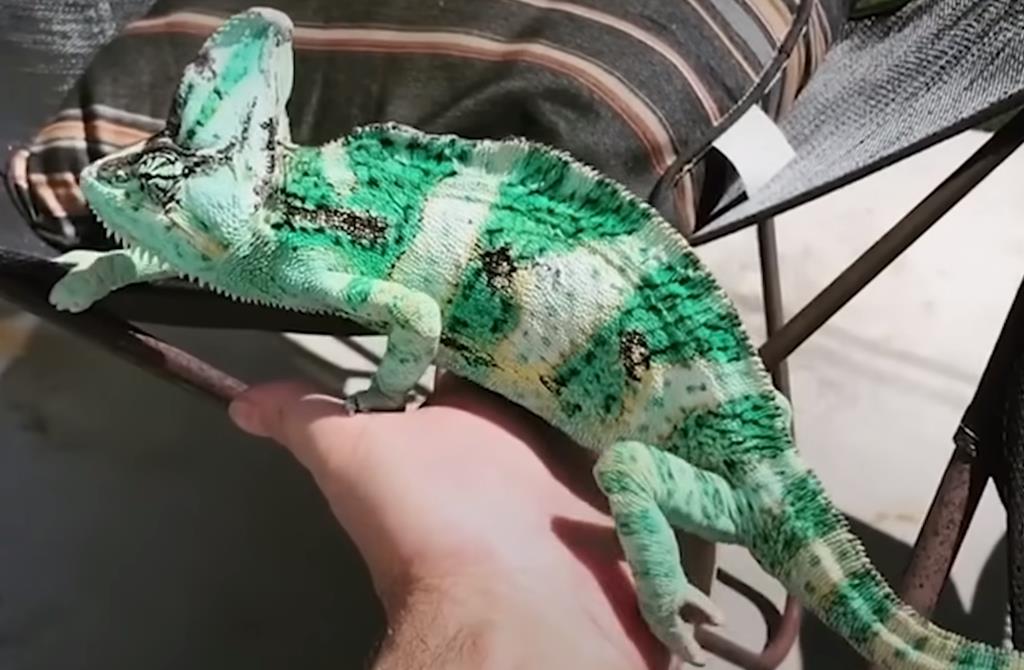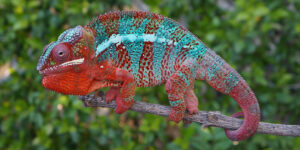Veiled chameleons can be challenging to keep alive and thrive as pets. They have specific habitat requirements, including proper temperature, humidity, and lighting. Their diet and hydration needs can also be complex. Additionally, they may not tolerate handling well. Success in keeping veiled chameleons often requires dedication, research, and a commitment to meeting their unique care requirements.
Veiled chameleons, known scientifically as *Chamaeleo calyptratus*, have captivated reptile enthusiasts with their striking appearance and fascinating behaviors. Native to the Arabian Peninsula, these creatures demand a dedicated caretaker due to their specific environmental and nutritional needs. Ensuring a long and healthy life for a veiled chameleon involves maintaining appropriate humidity levels, providing a diet rich in variety, and mimicking their natural habitat as closely as possible within an enclosure.
Their life span, typically around 5-8 years in captivity, often reflects the quality of care they receive. Novice reptile owners may find the task daunting, but with thorough research and commitment, keeping a veiled chameleon alive can be a rewarding experience.
Veiled Chameleon Fundamentals
Veiled chameleons require careful husbandry to thrive. Incorrect care can make their survival challenging.
Embracing the Veiled Chameleon Fundamentals is the first step in becoming a proud pet owner of these fascinating creatures. Their unique habits and striking physical features set them apart in the reptile world. Understanding what makes the veiled chameleon tick is crucial. It’s all about providing a matching environment and knowing what to expect as they grow. Let’s delve into the essentials of their natural habitat and behavior, as well as the lifespan and physical characteristics of veiled chameleons.
Natural Habitat And Behavior
The veiled chameleon’s world in the wild is both complex and interesting. Bold tree dwellers, they are native to the Arabian Peninsula, specifically Yemen and Saudi Arabia. These reptiles thrive in diverse environments, ranging from the cool highlands to the warmth of desert valleys.
- Adapted to arid climates but prefer humidity
- Spends most of their time amongst branches
- Excels in camouflage; changes colors based on mood and temperature
- Solitary by nature; doesn’t crave company
Simulating this aspect of their habitat in captivity is not only beneficial but necessary. A tall enclosure with plenty of vegetation and climbing branches mirrors their natural surroundings. A proper balance of heat, light, and humidity is fundamental to their well-being.
Lifespan And Physical Characteristics
A veiled chameleon can live a healthy life for 5 to 8 years with proper care. This lifespan is dependent on genetics and the quality of their environment and diet.
| Characteristic | Description |
|---|---|
| Size | Males reach up to 24 inches; females are smaller |
| Color | Usually bright green with bands; can change with mood |
| Head Crest | Distinctive casque grows taller with age |
| Sexual Dimorphism | Males more vibrant and larger; females often have a shorter lifespan |
It’s vital to note that veiled chameleons are sensitive to stress and can be affected by improper handling. Monitoring their physical condition for signs of stress is just as important as getting their habitat right.
Common Challenges In Caring For Veiled Chameleons
Veiled chameleons mesmerize onlookers with their vibrant colors and remarkable adaptability. Yet, raising these creatures requires more than fascination. They have specific needs. Owners face several challenges to keep these reptiles thriving. This section sheds light on those challenges with solutions to ensure a healthy, happy chameleon.
Sensitivity To Environment
Veiled chameleons need a specific habitat. They thrive in controlled environments that mimic their natural ecosystem. Several factors play a role:
- Temperature: It should range between 72-80°F during the day and drop to 60-70°F at night.
- Humidity: They require 50-70% humidity. Owners must monitor levels daily.
- Lighting: UVB lighting is crucial for their health. A 12-hour light cycle is optimal.
Failure to meet these conditions can result in stress and health issues.
Dietary Requirements
Feeding veiled chameleons involves more than just providing food. Their diet is diverse and needs careful planning:
| Food Type | Frequency | Notes |
|---|---|---|
| Insects | Daily | Gut-loaded prior to feeding. |
| Greens | Weekly | Small amounts of safe leafy greens. |
| Supplements | Weekly | Calcium and vitamins are essential. |
Proper nutrition prevents metabolic bone disease and supports growth.
Stress Factors
Stress can be deadly for veiled chameleons. Countless elements contribute to their stress levels:
- Handling: They prefer minimal contact. Frequent handling can cause stress.
- Reflections: Avoid placing the habitat near reflective surfaces to prevent self-stress.
- Companionship: Veiled chameleons are solitary. Other chameleons can stress them.
Understanding these factors is crucial to creating a stress-free environment for your pet.
Optimizing Their Living Space
Optimizing Their Living Space is a pivotal step in ensuring a happy and healthy life for your veiled chameleon. These exotic pets rely on us to recreate their natural habitat. This artificial environment plays a critical role in their overall well-being. Let’s guide you through setting up a terrarium that mirrors their wild environment as closely as possible.
Setting Up The Right Terrarium
Veiled chameleons need room to move, climb, and explore. A tall, vertical terrarium works best for them. Aim for a size that is at least 24 inches wide, 24 inches long, and 36 inches tall. The enclosure should have ample ventilation, with a combination of glass and mesh. Glass helps maintain humidity, while a mesh top allows for good airflow. Inside, include branches and vines for climbing. They should vary in size to aid exercise and foot health.
Temperature And Humidity Control
Veiled chameleons thrive in areas that mimic their natural habitat’s temperature and humidity. Use a digital hygrometer to keep track. Maintain temperatures between 72-80°F during the day and 65-70°F at night. Create a basking spot that reaches up to 85-95°F. Humidity levels should stay between 50-70%. Mist the terrarium twice daily or use an automated mister to manage humidity.
Lighting And Plant Arrangement
Your chameleon needs UVB lighting to synthesize vitamin D3. This vitamin helps them absorb calcium. Place UVB lights within 8-12 inches from where they perch. Cycle the lights to mimic day and night, providing 12-14 hours of light each day. Arrange live plants like ficus, pothos, or dracaena. These plants not only mimic their natural habitat but also help maintain humidity. Ensure that the plants are safe and non-toxic to chameleons.
Feeding Your Veiled Chameleon
Feeding your veiled chameleon is vital for its health and longevity. A nutritious diet ensures your pet thrives in captivity. Let’s explore how to best meet your veiled chameleon’s dietary needs.
Understanding Their Diet
Veiled chameleons are omnivores. In the wild, they eat a mix of insects and plants. Your pet needs a similar variety. Start with gut-loaded insects like crickets or mealworms. Include leafy greens and veggies for nutritional balance.
Supplements And Hydration
To prevent metabolic bone disease, supplement with calcium and vitamins. Dust food with calcium powder twice a week. Add a multivitamin to the mix every two weeks. Proper hydration is also crucial. Provide a drip system or mist for drinking water.
Feeding Schedule And Best Practices
Babies need daily feedings, while adults can eat every other day. Stick to a consistent schedule and watch portion sizes. Remove uneaten food to prevent spoilage and bacteria growth. By following these best practices, you’ll keep your veiled chameleon healthy and content.
Health Concerns And Prevention
Veiled chameleons captivate with their colorful displays and unique behaviors. Yet, like any pet, they require dedicated care to thrive. Awareness of their health concerns and effective prevention strategies is key to their longevity. In this section, we’ll explore the signs of illness to watch for, routine health checks to perform, and common diseases along with their treatments.
Recognizing Signs Of Illness
Vigilance is crucial in maintaining the health of a veiled chameleon. Identifying signs of distress early can mean the difference between a simple recovery and a serious health problem. Pay attention for indications such as lethargy, loss of appetite, discolored skin, and abnormal droppings. If your chameleon displays any unusual behaviors, it may be time for a visit to the veterinarian.
Routine Health Checks
Regular health assessments are vital. Schedule monthly checks to examine your chameleon’s physical condition and habitat. Review elements such as skin integrity, eye health, and habitual activity levels. Consistent monitoring ensures a stable environment and helps prevent the onset of disease.
Common Diseases And Treatments
A variety of ailments can afflict veiled chameleons. Familiarize yourself with conditions such as Metabolic Bone Disease (MBD), respiratory infections, and parasitic infestations.
| Disease | Symptoms | Treatments |
|---|---|---|
| Metabolic Bone Disease (MBD) | Weakness, deformed limbs | UVB lighting, dietary calcium |
| Respiratory Infections | Labored breathing, mucus | Antibiotics, proper humidity |
| Parasitic Infestations | Weight loss, appetite change | Anti-parasitic medication |
Consult a reptile specialist for an accurate diagnosis and advice on suitable treatments. Preventative measures, such as maintaining a clean habitat and providing a nutrient-rich diet, minimize disease risks. With proper care, veiled chameleons can lead healthy, vibrant lives.
Expert Tips For Longevity And Well-being
Welcome to the insider’s guide on enhancing the lifespan of your veiled chameleon. Discover the secrets to a thriving pet chameleon through expert insights into their care. Carefully tailored for both novices and seasoned keepers, these tips guarantee your little reptilian buddy enjoys a life brimming with well-being.
Handling And Interaction Guidelines
Maintaining your veiled chameleon’s health involves correct handling. Let’s jump into how to interact with your pet safely:
- Limit the handling to a minimum to reduce stress.
- When picking up your chameleon, be gentle and let them climb onto your hand.
- Keep handling sessions brief and infrequent, ideally no more than once weekly.
- Always wash your hands before and after to prevent the spread of germs.
Breeding Advice
Breeding veiled chameleons can be complex. Observe these pointers to encourage successful mating:
- Ensure both male and female are healthy and mature.
- Set up a separate enclosure for mating to give them privacy.
- Monitor interactions closely to prevent aggressive behavior.
- Provide extra nutrients for the female during egg-laying and recovery.
Staying Informed On Chameleon Care
Keep your chameleon happy by staying updated with the latest care techniques:
- Join reptile forums and groups for shared experiences and advice.
- Read books and articles from reputable sources about chameleon care.
- Consult with a reptile vet for personalized care instructions.
- Watch for behaviour changes; they often signal health issues.
Frequently Asked Questions On Are Veiled Chameleons Hard To Keep Alive?
Are Veiled Chameleons Good For Beginners?
Veiled chameleons can be challenging for beginners due to their specific habitat and dietary needs. They require precise temperatures, humidity levels, and UVB lighting, which must be meticulously maintained. Beginners need to commit to learning and providing proper care.
What Do Veiled Chameleons Need To Survive?
To survive, veiled chameleons need a well-ventilated enclosure, UVB lighting, and thermal gradients. They also require a varied diet of gut-loaded insects and fresh vegetation. Regular misting or a drip system ensures they stay hydrated, as they rarely drink from a water bowl.
How Long Do Veiled Chameleons Typically Live?
With proper care, veiled chameleons live between 5 to 8 years. Their lifespan is impacted by factors such as diet, environment, and general health. Routine veterinary care can help prevent and address common health issues, potentially extending their life expectancy.
Can Veiled Chameleons Get Sick Easily?
Veiled chameleons can get sick if their specific care requirements aren’t met. Common health issues include metabolic bone disease, respiratory infections, and dehydration. Prompt attention to habitat, nutrition, and early signs of illness can reduce the risk of diseases.
Conclusion
Caring for veiled chameleons demands attention to detail and commitment. These exotic pets require a specific habitat, diet, and maintenance routine. With proper care, they can thrive and bring a fascinating dynamic to your home. Passionate keepers find their efforts rewarding, ensuring these creatures live healthy, vibrant lives.
Embrace the challenge and enjoy the unique journey of veiled chameleon care.



